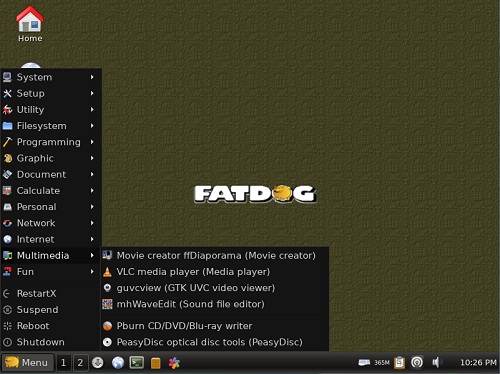

FatDog is a 64-bit Linux Distro based upon Puppy Linux. Booting from a FatDog ISO file is covered elsewhere in this document (see here).
For more information about FatDog64 refer to http://distro.ibiblio.org/fatdog/web/ -
FatDog64 version 7.01 was used during testing - similar settings may also work with other versions. FatDog screenshot -

FatDog does not require a SquashFS (SFS) file or any other dependencies and can be booted successfully with a Linux kernel and initrd file - making it very PXE friendly!
To PXE Boot FatDog, download the ISO file (Fatdog64-701.iso ).
Now create the folder \fatdog701\ in your Tiny PXE Server root directory - e.g. C:\pxesrv\files\fatdog701\.
Now extract the following files from the FatDog ISO (mount it in ImDisk, or extract using 7-zip, or use a tool of your choice) and copy them to C:\pxesrv\files\fatdog701\ -
Tiny PXE Server directory structure -
Now add a menu entry for your preferred Network Bootstrap Program -
Remember to ensure that the required files are copied to your Tiny PXE Server root directory -
Add the following to C:\pxesrv\files\pxelinux.cfg\default (create this file if required) -
Click on one of the following for sample config.ini settings (edit to reflect your own setup) -
Remember to ensure that the required files are copied to your Tiny PXE Server root directory -
Add the following to C:\pxesrv\files\menu.lst\default (create this file if required) -
Click on one of the following for config.ini settings (edit to reflect your own setup) -
Remember to ensure that the required files are copied to your Tiny PXE Server root directory -
Add the following to the menu section of C:\pxesrv\files\ipxe_menu.txt (create this file if required) -
Add the following to the menu options section of C:\pxesrv\files\ipxe_menu.txt -
E.g. -
NOTE - remember to change set boot-url http://${dhcp-server} if using ProxyDHCP.
Click on one of the following for config.ini settings (edit to reflect your own setup) -
iPXE menus are essentially complicated scripts. It's also possible to specify a script using the altfilename option in config.ini. NOTE - remember to change set boot-url http://${dhcp-server} if using ProxyDHCP.
Sample iPXE script -
Document date - 28th February 2017(DRAFT)